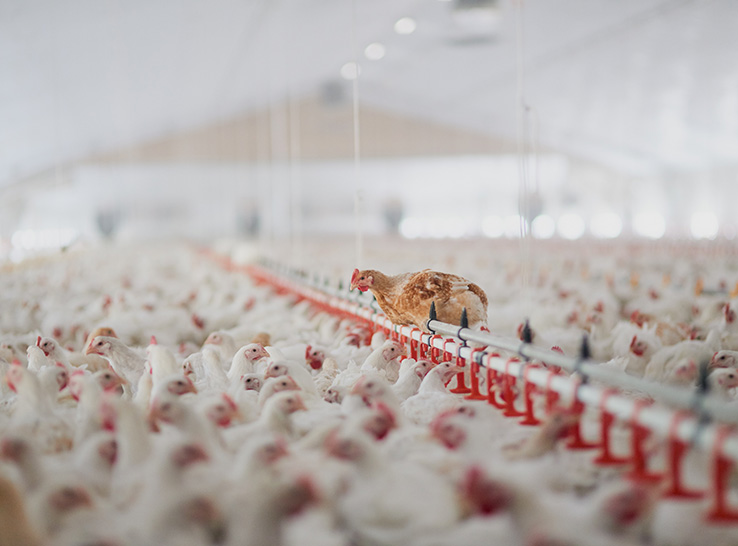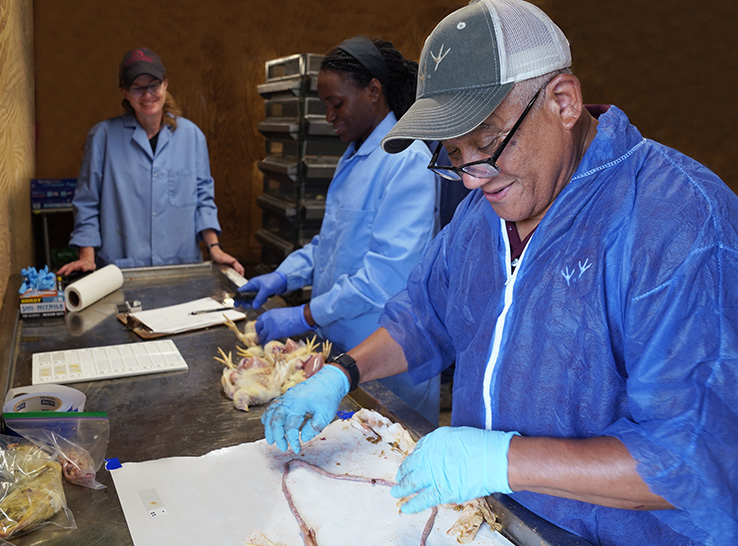Poultry veterinarians and producers know the importance of managing coccidiosis and its two major species — Eimeria maxima and Eimeria tenella. If left unchecked, they can compromise gut health, feed conversion and flock performance. What many don’t realize is that the so-called minor species of coccidia can undermine control efforts, too.
“Coccidiosis is a challenge that has been with us for a long time,” says Steve Fitz-Coy, PhD, a leading poultry parasitologist at Merck Animal Health who has devoted much of his career to coccidiosis research.
“Our research and testing show we have done a good job of addressing the primary threats, E. maxima and E. tenella. However, we have learned that Eimeria mivati and other minor species also deserve our attention to more fully reduce performance losses.”
More to the cocci picture
Addressing minor species may be the key to “cracking the code” for more thorough coccidiosis control, helping farms retain higher profitability by not allowing “minor” cocci issues to build into major problems, Fitz-Coy says.
For the better part of four decades, coccidiosis in the US poultry industry was effectively managed with the use of ionophores — a class of antibiotics used in animals only. These included lasalocid, monensin, narasin and salinomycin.
Ionophores kept the disease and performance losses in check and were considered effective against all economically significant Eimeria species, as s long as they were rotated to maintain their efficacy.
However, beginning in the early 2010s, there was a major shift away from using ionophores as producers flocked to “no-antibiotics-ever” (NAE) production schemes, which now make up about 50% of production. For many, that meant incorporating coccidiosis vaccines, which are usually administered in hatcheries, into their program to replace ionophores and/or complement non-antibiotic feed medications.
When administered and managed correctly, vaccines have proved to be effective tools for protecting birds against E. maxima and E. tenella, as well as what Fitz-Coy calls the “second-tier’” threat Eimeria acervulina, which does not lead to the mortality of E. maxima and E. tenella but causes noticeable symptoms and performance loss.
Fitz-Coy warns that E. mivati has the potential to cause economically significant performance losses in poultry if not addressed in coccidiosis-management programs. While ionophores and synthetic anticoccidials effectively control E. mivati, not all vaccines protect against it. He recommends checking the vaccine’s label to ensure E. mivati is indicated.
Rise of E. mivati
For many years E. mivati was a source of controversy among poultry pathologists. Some believed it to be a distinct Eimeria species that posed a threat to broilers, while others were doubtful and considered it a variant of existing species already addressed by control measures.
Studies conducted by Fitz-Coy and colleagues coupled with the rise of PCR testing put the debate to rest, showing that E. mivati is a unique type of Eimeria with an estimated prevalence as high as 30%, Fitz-Coy says.
The latest studies conducted by Fitz-Coy further confirm previous E. mivati results while adding greater detail. They also indicate that two additional minor Eimeria species — E. hagani and E. praecox — should be given more consideration in coccidiosis management. Fitz-Coy presented his full data and analysis on these latest findings for E. mivati, E. hagani and E. praecox at the 2024 Poultry Science Association’s meeting.
“Our findings add to the growing body of evidence that E. mivati and other minor Eimeria species deserve more attention,” Fitz-Coy says.
“It’s clear these species have become increasingly prevalent since ionophore use has been reduced,” he continues. “They contribute to coccidiosis. They undermine optimal health and performance. They represent significant ‘hidden losses’ for our industry. While we have learned the most about E. mivati in recent years, it’s clear we also need to continue looking closer at E. hagani and E. praecox.”
Because minor Eimeria species have been lesser known and unaddressed, it’s likely there have been many instances where they have eluded common detection and mitigation strategies, he observes.
“You may have a situation where the major Eimeria species are effectively controlled, yet symptoms of coccidiosis are present. In these cases, it may be E. mivati and other minor species that are causing the issue,” he explains.
Keeping perspective
When assessing coccidiosis, it’s important to remember that each organism has its own style and way of compromising flock performance, Fitz-Coy says. For example:
- “E. acervulina is like your car alarm. It’s a screamer. It hollers. It’s very noticeable when you have a problem,” he explains.
- “E. maxima is a bandit. It quietly comes in the night and robs you. It’s not as noticeable, but the damage you can’t see is very high.
- “E. tenella is like a butcher. It will make a mess if it’s not taken care of properly because it causes the most mortality.”
By comparison, the minor Eimeria species are an annoyance — causing modest symptoms and not mortality, he notes. However, with the increasing prevalence of these minor species, their economic significance is growing.
“Particularly with the scale and tight margins of poultry operations today, even issues that may be more minor in nature can quickly add up to significant losses,” Fitz-Coy says.
“If we’ve learned one thing in our recent research, it’s that E. mivati and the other minor species have a greater impact on health and performance than we’ve given them credit for. By addressing them, we can make an important improvement to the success of poultry operations.”
Increasing success
It’s possible ionophores could once again become a bigger part of coccidiosis management following recent announcements by companies pulling back on NAE programs, he notes. “However, I suspect this will happen slowly, and we won’t go all the way back to how these tools were relied upon in the past.”
For now, the focus for Fitz-Coy and colleagues is to continue to raise awareness of E. mivati and other minor Eimeria strains to give veterinarians, producers and other decision-makers across the industry a clearer picture of what they’re up against.
“If we can expand our focus to also include the minor species, we will be that much better off in minimizing production losses,” he says. “This can be a quick and significant win for our industry.”
Editor’s note: Content on Modern Poultry’s Industry Insights pages is provided and/or commissioned by our sponsors, who assume full responsibility for its accuracy and compliance.









